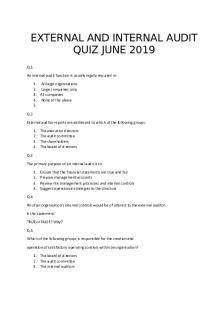IOP CAM Internal and External Analysis PDF

| Title | IOP CAM Internal and External Analysis |
|---|---|
| Course | Life and Works of Rizal |
| Institution | San Beda University |
| Pages | 2 |
| File Size | 94.7 KB |
| File Type | |
| Total Downloads | 50 |
| Total Views | 137 |
Summary
How to use IOP CAM, Internal and External Analysis...
Description
FRANCISCO, Norriedel S. 1BPS- Philippine History Photograph title: The Falling Soldier or Loyalist Militiaman at the Moment of Death, Cerro Muriano, September 5, 1936 Information
depict the death of a Republican Iberian Federation of Libertarian Youth soldier, during the Battle of Cerro Muriano in the Spanish Civil War
Origin The Falling Soldier is a black and white photograph Robert Capa, Perspective
Context Audience Motive
He is considered by some to be the greatest combat and adventure photographer in history. claimed to have been taken on Saturday, September 5, 1936 Public viewers Capa pushes the viewer to find meaning in the moment of death of a person.
Table 1 (The Falling Soldier analysis using IOP CAM) The falling soldier is a black and white photograph that depicts the death of a Republican Iberian Federation of Libertarian Youth soldier, during the Battle of Cerro Muriano in the Spanish Civil War, and was written by Robert Capa, one of the greatest combat and adventure photographer in history. The photograph was taken on Saturday, September 5, 1936, and then released to the public viewers to find meaning in the moment of death of a person.
External criticism is concerned with establishing the authenticity your genuineness of data historians checks the source to verify whether or not its authentic. For Robert Capa’s falling soldier, there were allegations from the Falange, an extreme nationalist political group in Spain, that the photograph was staged. However, outside of Spain, it remained unquestioned as a legitimate documentary photograph until the 1970s. Staging photos was a common occurrence during the Spanish Civil War because of limits imposed upon photojournalists' freedom of movement: unable to go to active fronts, or cordoned off when they were, photographers resorted to pictures of soldiers feigning combat. we have to look for inquiries regarding authorship, originality
and accuracy of copy. And if errors were found, external criticism helps with determining the nature of the errors, may it be scribal errors or other kinds of errors. In the photograph The falling soldier, In José Manuel Susperregui's 2009 book Sombras de la Fotografía ("Shadows of Photography"), he concludes that the photograph was not taken at Cerro Muriano, but at another location about 30 miles (48 km) away. Susperregui determined the location of the photograph by examining the background of other photographs from the same sequence as the Falling Soldier, in which a range of mountains can be seen. He then e-mailed images to librarians and historians in towns near Córdoba, asking if they recognized the landscape, and received a positive response from the Spanish town of Espejo. Because Espejo was miles away from the battle lines when Capa was there, Susperregui said this meant that the Falling Soldier photograph was staged, as were all the others in the same series, supposedly taken on the front. We can see here that we proved a primary source is forged by examining the place the event took place, and the location where the photograph was taken.
Internal criticism means to test the credibility of a source rather than checking its authenticity, This means to look at the text itself, author’s point of view and the accuracy of the content. There are 5 ways on how to test the accuracy of the event. Namely; Identification of the author, determining the approximate date, Author’s ability to tell the truth, willingness of the eyewitness to tell the truth and looking for corroboration. Robert Capa is one of the greatest combat and adventure photographer in history. He is known for his black and white photographs that are mainly during the Spanish war. The photo was taken on September 5, 1936 which is the same time the war is taking place. Although, Robert Capa may not be the best candidate to be the example of telling the truth, since it was examined that the photograph itself is forged and staged. Nevertheless, Robert Capa’s motive to encourage the public viewers to find meaning in the moment of death of a person, can still be felt while looking at the photograph taken....
Similar Free PDFs

Internal and external constraint
- 3 Pages

Internal vs. External Forces
- 2 Pages

Internal Law Vs External Law
- 10 Pages

Internal Analysis
- 6 Pages

Internal Analysis
- 10 Pages

External Analysis Final
- 8 Pages

External Environment Analysis Report
- 28 Pages
Popular Institutions
- Tinajero National High School - Annex
- Politeknik Caltex Riau
- Yokohama City University
- SGT University
- University of Al-Qadisiyah
- Divine Word College of Vigan
- Techniek College Rotterdam
- Universidade de Santiago
- Universiti Teknologi MARA Cawangan Johor Kampus Pasir Gudang
- Poltekkes Kemenkes Yogyakarta
- Baguio City National High School
- Colegio san marcos
- preparatoria uno
- Centro de Bachillerato Tecnológico Industrial y de Servicios No. 107
- Dalian Maritime University
- Quang Trung Secondary School
- Colegio Tecnológico en Informática
- Corporación Regional de Educación Superior
- Grupo CEDVA
- Dar Al Uloom University
- Centro de Estudios Preuniversitarios de la Universidad Nacional de Ingeniería
- 上智大学
- Aakash International School, Nuna Majara
- San Felipe Neri Catholic School
- Kang Chiao International School - New Taipei City
- Misamis Occidental National High School
- Institución Educativa Escuela Normal Juan Ladrilleros
- Kolehiyo ng Pantukan
- Batanes State College
- Instituto Continental
- Sekolah Menengah Kejuruan Kesehatan Kaltara (Tarakan)
- Colegio de La Inmaculada Concepcion - Cebu








